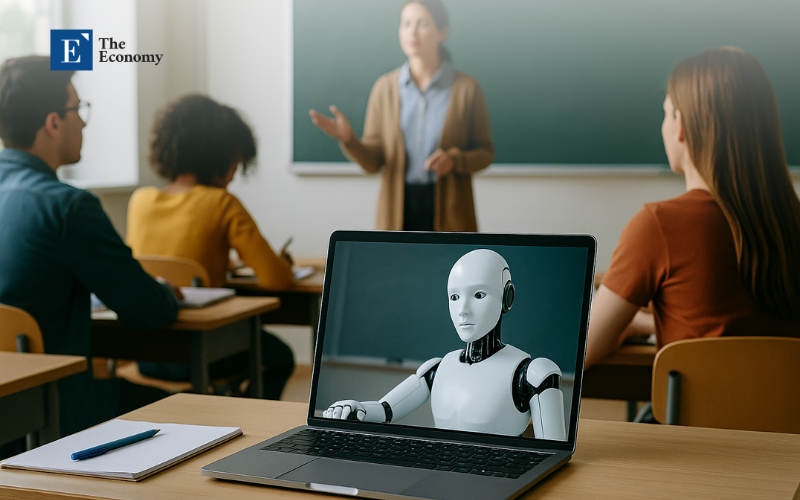From Search to Stream: How AI Is Turning Media Into Interactive Learning
Input
Modified
It reads your videos. It learns your files. Search expands beyond text and becomes personalized. Education and automation are at the forefront of new capabilities.
In a bold update to its core platform, Google has rolled out AI Mode for its search engine, bringing semantically aware tools to video, camera input, and user files. The system no longer just retrieves links; it also analyzes them. It analyzes content, interprets visual and spoken data, and responds with context-aware answers. This evolution is not unique to Google. OpenAI and others already offer similar features aimed at students and professionals alike. As the interface between humans and machines becomes more fluid, the potential for transforming education and even replacing routine jobs is rapidly growing.

Search In Your Streams
Traditional search engines handle typed queries, keywords, phrases, and URLs. With AI Mode, Google’s search can now analyze the content of videos you’ve recorded, the audio in meetings, and even the documents saved on your device. That means students can submit a lecture video they recorded and ask the professor what they said about a specific topic. They can snap a picture of a whiteboard and instantly receive structured bullet points. The system becomes a dynamic assistant, parsing multimedia data rather than relying on user summarization.
For many students, this offers a new way of engaging with course material. Instead of manually reviewing recordings or retyping notes, the AI summarizes, highlights, or clarifies content. Google positions this as part of its “Back To School” AI updates, emphasizing practical tools that allow students to interact more efficiently with their content.
OpenAI already offers a similar feature through its chatbot interface. Students can submit lecture slides, PDF readings, or canvas screenshots, and the model will answer questions based on that material. While there are differences in style and pricing, the core logic remains the same: search should not depend solely on keyword recall, but should derive meaning from context-rich sources.
Desk Jobs Meet Automation
Beyond education, the implications of this AI enrichment are vast. Firms that rely on routine data entry, transcription, basic content creation, or standardized customer responses may find themselves competing with the same tools students use in classrooms.
Consider a typical office workflow: video meetings get transcribed manually, basic customer questions get answered via email templates, and content is updated in bulk across shared files. Now imagine an AI that automatically extracts key insights from meeting audio, crafts intelligent summaries, and updates documentation without human intervention. That shift has already begun. Combined with emerging agent models on the desktop, these tools may soon take over tasks once reserved for entry-level employees.
According to analysts, jobs such as transcription, first-tier customer support, simple report generation, or standard research tasks could be under threat. The tools may not entirely replace a human team, but they can streamline operations, reducing overhead and shifting the balance toward higher-level collaboration.
With Google and OpenAI driving innovation, background tasks once performed by humans are increasingly being automated through algorithms. For businesses, that means savings. For workers, it means adaptation or disruption.

Education and Equality in a New AI Era
In schools and universities, AI Mode and its equivalents offer powerful capabilities. Still, they also raise concerns that if every student can submit course PDFs, video lectures, or assignments to an AI assistant, the boundaries of academic integrity blur. How does one distinguish between a well-guided response and one generated entirely by the model? Institutions must now decide what constitutes acceptable use.
Moreover, while the core AI features may be free, full functionality often requires premium access. Students with access to subscription tiers may receive better assistance, faster processing, and deeper interactions. That means disadvantaged learners risk falling behind, primarily if their institutions do not provide access subsidies.
Educators must also consider whether AI will encourage dependence. Students may rely on automated summaries rather than developing critical reading, notetaking, and reasoning skills. If the tools do much of the cognitive heavy lifting, what gets lost in the process?
Yet the benefits are tangible. Students juggling work, school, and personal commitments can use AI to review lecture content, receive instant clarifications, and reinforce weak areas on demand. When integrated thoughtfully, these tools enhance learning outcomes, particularly for students who struggle with traditional educational timelines.
As AI becomes more adept at analyzing live lectures, recorded videos, and written content, it accelerates both opportunity and debate. Education systems must navigate the complexities of fairness, access, and evolving definitions of competence. Meanwhile, businesses must adapt to a world where routine labor is increasingly automated.
In the coming months, the debate will widen. Policy makers, educators, technologists, and students will engage in critical conversations about how AI reshapes both the classroom and the workplace. The tools may be ready. The rules for their use, equity, and consequences are still forming.





















